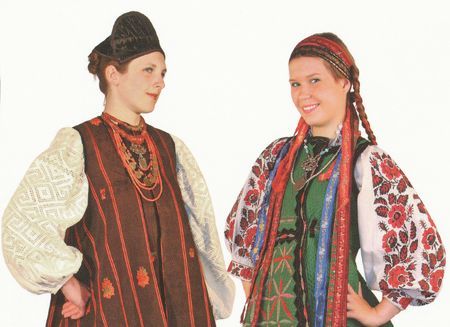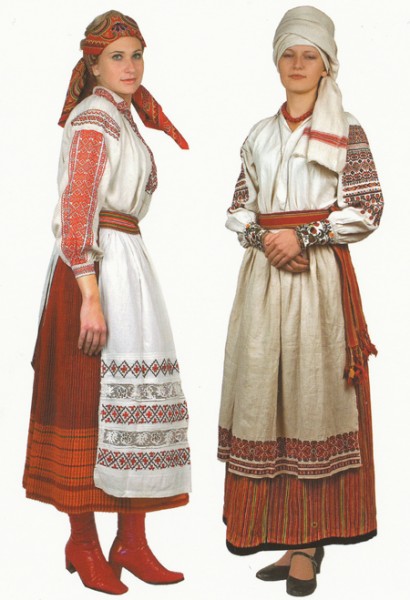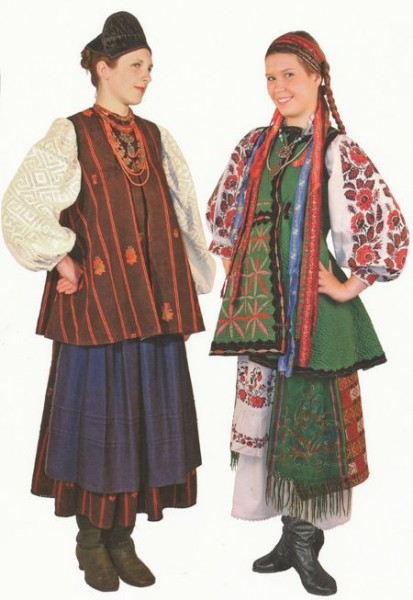What did our grandparents wear?
Ceremonial awarding of the main prize of the International Exhibition “Book Art” to the famous Ukrainian ethnographer Oksana Kosmina will take place in early September in Moscow
Oksana Kosmina will be honored with this award as the author of the book Ukrainian Traditional Clothing published by the Kyiv based publishing house “Baltia-Druk.” The first volume titled Lisostep. Step (Forest Steppe. Steppe) was published in 2008 and the second one – Polissia. Karpaty (Polesia. The Carpathians) was published in 2011. It is the first popular science publication, which reveals the poetic image of Ukrainian costumes in all their diversity. The book is richly illustrated, contains historical and ethnographic information, it especially focuses on the art features and symbolic elements of folk costume. With unique photographs of the authentic costumes made in 22 museums and private collections in Ukraine, a reader first has a chance to get familiar with elements of folk costumes, hats, shoes, jewelry, accessories, and appreciate the rich colors of decoration. The text is accompanied by a glossary of terms that reflect the realities of national life of the early 20th century, widely used at the time, but now, unfortunately, known only to a narrow circle of specialists.
Two volumes of Ukrainian Traditional Clothing won the Grand Prix of the 10th International Contest of CIS countries “Book Art” held in spring in Minsk (Belarus), and the ceremonial awarding of the prize will be held in September in the capital of Russia.
Kosmina’s work belongs to the rare example of modern scientific literature, she made a decisive step towards overcoming the approach of not differentiating historical and cultural regions with natural geographic ones deeply rooted in Ukrainian ethnology. Scholars still quite often enumerate with an “and” such diverse non-alternative definitions as Bukovyna and Hutsul region, Volyn and Polesia, Transcarpathia and Boikivshchyna, etc. They also do not take into account that territories of some natural and geographic regions (the South, Polesia), ethnic and cultural subregions, and ethnic groups can simultaneously belong to different historical and cultural regions and historical lands. For example, Boikos and Lemkos live in Galicia and Transcarpathia, while Hutsuls live in the same area and also in Bukovyna.
The author consistently goes beyond the geographical dominant, dividing the territory of Ukrainians settlement in natural areas – Polesia, Forest Steppe, Steppe, and the Carpathians. Some historical lands (for example Podolia, Poltava region, Tavria, and Budzhak) are located entirely within a single natural and geographical area, other lands can be distributed on the areas of Forest Steppe and Polesia (for example Volyn, Kyiv region, Chernihiv region), Forest Steppe and Steppe (Sloboda region), or Forest Steppe and the Carpathians (Bukovyna and Galicia).

A GIRL AND A YOUNG LADY IN HOLIDAY ATTIRE (FROM THE COLLECTION OF VOLYN ETHNOGRAPHY MUSEUM). DEMONSTRATED BY THE MUSEUM STAFF / Illustration from the book Ukrainian Traditional Clothing
Oksana Kosmina, Ph.D. in History, is an ethnographer by profession, an architect by education, and an artist in her world view. She presents the traditional Ukrainian clothing in two dimensions. The text contains all the necessary information about a wide range of women’s and men’s clothing in various regions, particular features of the materials used for making underwear and upper parts, accessories and jewelry, description of style and decor, etc. While the visual images show the items of clothing primarily as a highly artistic phenomenon thanks to the diligent work of the publishing house “Baltia-Druk,” expressive artistic design of the book (Liubov Androshchuk) and talented photographers Viktor Khmara, Vitalii Mashkov, and Oleksandr Ivanov.
Readers are greatly impressed with the careful selection and interdependence of practically all components of the two volume publication, which makes it similar to a slender and graceful architectural structure or a complex musical piece, where the topics outlined by the overture develop in the further parts of an opera or a symphony. The publishers picked an optimal album format for publishing such type of work, close to square shape, combination of opaque cover with silver fabric on the rounded spine, harmonious in color and texture.
There is also an interesting design of headers with varying patterns for each unit. In general, the word “game” can be a key word to describe the entire publication. Traditional costumes on modern girls and boys, young men and women (there are no older people among the models) is, of course, clearly a theatrical move.
Today young ladies, unlike their great-grandparents, successfully mastered their native heritage and look not just natural, but also exquisitely elegant, wearing traditional clothes.
Two volume publication by Kosmina has many positive features. The publication entitled Ukrainian Traditional Clothing is 100 percent dedicated to festive peasant clothing of the late 19th – early 20th century.

Similarly, the map “Historical and Ethnographic Zoning of Ukraine” should be subtitled “With Regard to Regional Clothing.” This would automatically remove a number of questions, such as the one about the boundary between Forest Steppe and Steppe in Donbas region, as well as the issue of whether the areas in the basin of the Dnipro and Prypiat belong to Podolia and whether the north-eastern part of Zakarpattia oblast belongs to the Transcarpathian region.
Kosmina pays tribute to more than a century long tradition of “mourning” of corrupted folk art in the 20th century by experts. Rightly noting the replacement, she prefers not to contemplate on the fact that the preserved samples of Ukrainian embroidery from the 17th and 18th centuries (albeit mainly belonging to the higher strata of the society) have phitomorphic patterns dominating in them.
The books have a unique value for representing the traditional festive clothing of Ukrainian peasants at the turn of the 19th and the 20th centuries with unprecedented range of presentation and refined artistic taste.
The new publication of Kosmina is dense in academic content and, at the same time, is elegant, joyful and playful, graceful, and it once again reminds us that cultural value is not measured in numbers, moreover, in kilograms and meters. It is difficult to recall right away a similar publication released in the past years that would achieve such perfection.
The books were published in Ukrainian and contain a detailed summary in English, thus extending the readers’ audience and involving a wide range of foreign readers into exploring our culture.
Newspaper output №:
№50, (2013)Section
Society





